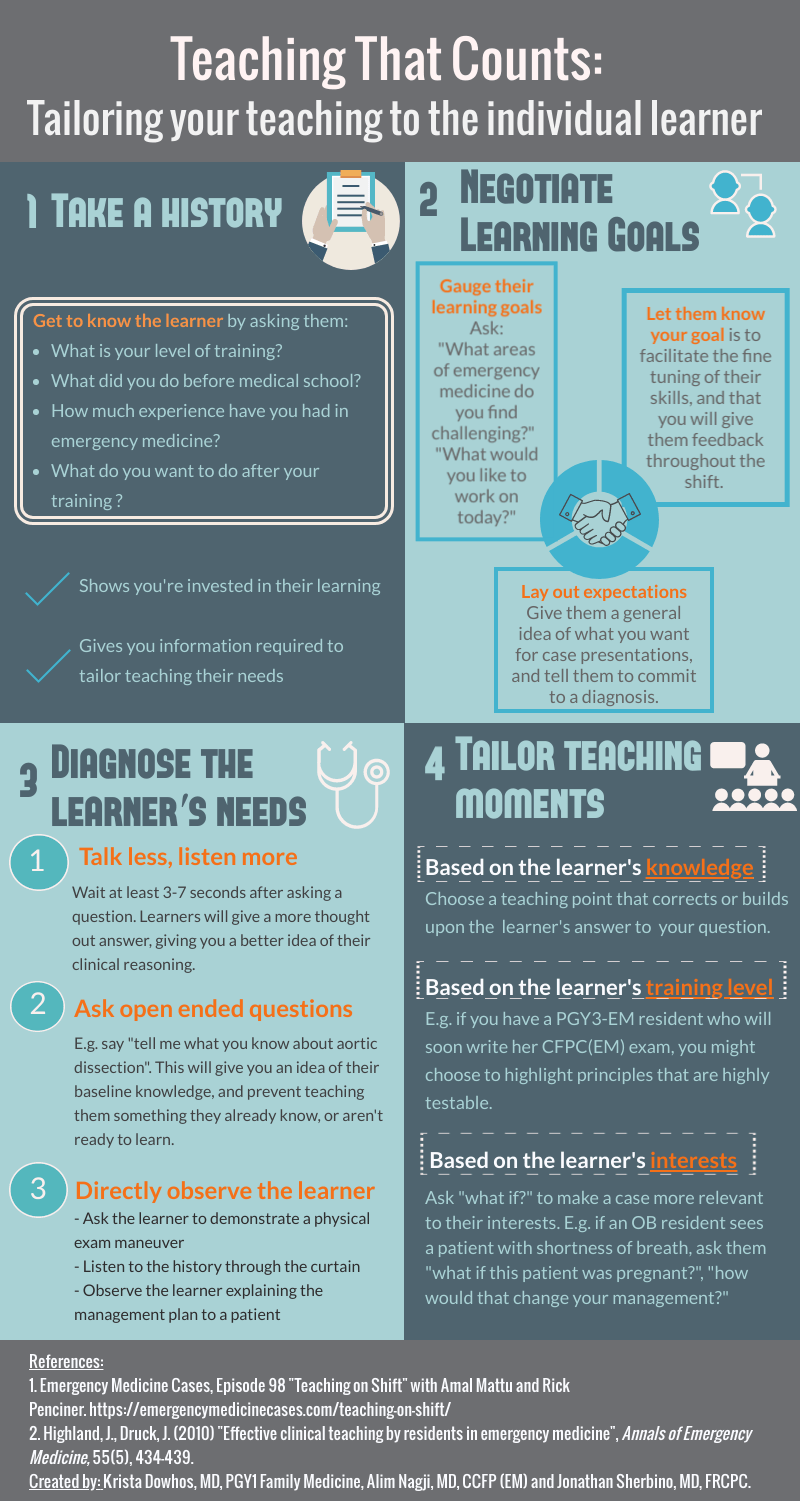This is part of the CanadiEM Teaching That Counts Infographic Series, where we take the current research and evidence on how to teach well in the emergency department, and distill it down into bite-sized chunks that are rapidly digestible and memorable.
Teaching That Counts: Tailoring Your Teaching to the Individual Learner
You wouldn’t treat a 70 year-old diabetic patient with chest pain the same way you would treat a healthy 17 year-old with chest pain, right? In the same vein, we shouldn’t teach a first-year medical student the same way we teach a senior emergency medicine resident. Just like we provide patient-centred care, we should provide learner-centred teaching!1 Tailoring your teaching to the individual learner can be done in four simple steps.
Step 1: Take a ‘focused history’
Uncovering a few basic facts about the learner can really guide your teaching in the right direction. Learn their level of training, their experience in emergency medicine so far, and what their interests are. This tells the learner that you are dedicated to their learning and sets the stage for a more nuanced approach to teaching.
Step 2: Negotiate a learning plan
First, get an idea of their learning goals. Simplify things by asking: “is there anything in particular you would like to work on or see today?” Then, set them up for success by being transparent about your expectations. Would you like them to review with you before or after they order investigations? Do you have any expectations as to how many patients they will see in a shift? Should they attend to any and/or all overhead pages for critically ill patients? The answers to these questions might be different for trainees at different levels, and clarifying them early can lead to a much smoother shift.
Step 3: ‘Diagnose’ the learner’s needs
We all know the quote by Sir William Osler: “Listen to your patient, he is telling you the diagnosis.”2 Well, the same principle applies to your learner. Ask them a broad, open-ended question around a certain topic. Listening to their answer (for more than 3 seconds!) will give you a snapshot of their level of knowledge on that topic.
For example, say “tell me what you know about the presentation of aortic dissection”. They may answer with “I think it presents with chest pain, similar to an MI, but I’m not too sure how to differentiate between the two.” Or, they may answer with “classically, it presents with tearing chest pain that is maximal at onset. I get worried if I see a patient with chest pain plus a neurological deficit, a new murmur, or asymmetrical pulses”. The two responses represent very different levels of knowledge on the topic of aortic dissection. By simply listening to their answer they will tell what they already know, and what they are ready to learn.
Step 4: Tailor your teaching moments to the individual learner
If you have followed steps 1-3, this step will naturally follow. You already have the information required to teach the learner what they want and need to know. Choose a teaching point that builds on their existing knowledge, which they have just revealed to you in step 3. Tailor the teaching point to the learner’s interests, which they disclosed to you in step 1. For example, let’s say you are teaching a first-year surgery resident, and they see a patient with shortness of breath. You can make the case relevant to their interests by asking “how would your differential change if this was a patient on a surgical floor post-op day #2 after a hemicolectomy?” Lastly, Tag Your Teachable Moment to make it stick!
- 1.Chinai S, Guth T, Lovell E, Epter M. Taking Advantage of the Teachable Moment: A Review of Learner-Centered Clinical Teaching Models. WestJEM. January 2018:28-34. doi:10.5811/westjem.2017.8.35277
- 2.Bliss M. William Osler: A Life in Medicine. New York, New York: Oxford University Press; 1999.



